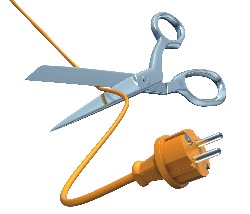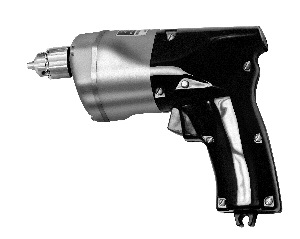 Back in the dark ages when this writer was young and foolish (as opposed to now when he is older and foolish), if a self-respecting workman needed to make a hole or cut something, he would walk to the closet, truck, toolbox, etc. and the first thing to come out was the dreaded extension cord. There was nothing better than dragging that cord up ladders, under hoods, across rafters, under dashboards — it was great I tell you!
Back in the dark ages when this writer was young and foolish (as opposed to now when he is older and foolish), if a self-respecting workman needed to make a hole or cut something, he would walk to the closet, truck, toolbox, etc. and the first thing to come out was the dreaded extension cord. There was nothing better than dragging that cord up ladders, under hoods, across rafters, under dashboards — it was great I tell you!
Well, along came a better idea that ruined all that fun. Power tools that ran not on AC current, but DC batteries! Genius! Now, the first cordless tool to hit the mainstream was the cordless drill. This first offering allowed technicians and craftsmen the freedom to fix, drill, loosen and tighten things without being tethered to that dreaded extension cord.

The Black & Decker Company introduced the cordless drill in 1961 (see photo at right). Shortly after that, Martin-Marietta contacted Black & Decker to develop tools on behalf of NASA that could withstand the harsh environment in outer space and zero atmosphere conditions. This partnership helped to improve and create new cordless tools including medical devices as well as the zero impact wrench. It seems that NASA didn’t want its astronauts spinning in circles while mining for moon rocks or while going on the earliest EVAs (that’s geek speak for Extra-Vehicular Activities) — us non-nerds call those space walks!
While those first cordless tools were an incredible advancement, they came with their fair share of drawbacks. In fairness to the tools, the problems with the early cordless tools were almost all battery related. The reality was that the engineering of the tools had far out-paced the battery technology of the day. The earliest tools suffered from all sorts of battery issues such as quick discharge, not holding charge, memory issues and others.
In addition to the above battery issues, the tools didn’t enjoy widespread acceptance due to cost and a general disdain for the technology. There were generations of technicians and workmen who were used to corded tools and believed they were the only solution for professionals.
Now let’s jump to modern day and explore cordless tools. It is now generally accepted that cordless tools are not only an acceptable tool for professional technicians and tradesmen, they are a prerequisite for workers. The tools provide unequalled convenience, performance and versatility. These tools have taken such a dominant role in the power tool market that they account for a large majority of the dollars and units sold by the major tool manufacturers worldwide. Many tool brands have significantly reduced their corded tool production in favor of cordless tool manufacturing.
Maybe the only bad thing about today’s cordless tool market is how many choices there are for technicians. One look around your tool dealer’s truck, or a visit to your favorite home store will provide you with more choices, colors, sizes, voltages, configurations, brands and kits than you could ever use in two lifetimes! The choices are nearly endless. As a technician, it can be especially overwhelming to know what the best choice is for your needs.
Hopefully, I can provide some information for you to think about before you make that next cordless tool purchase.
Battery Voltage/Type
Before we discuss the actual tools you are looking for, we need to think about voltage and battery style. We all know someone who is fighting the dreaded battery voltage/type battle. This is the phenomenon where a technician ends up with multiple brands and voltages of cordless tools. Now don’t get me wrong, this is an easy thing to do for all kinds of reasons. Perhaps you started out loyally buying brand X of cordless tools. One day your tool dealer comes in and shows you the latest new wiz-bang drill by brand Y. Maybe it’s got more power or accessories or a great price, etc., etc., and you make a new purchase. You see how easily this can happen and probably has already happened to you!
The downside to this approach is the need on your part to manage multiple batteries and chargers. Depending on how out of hand this situation gets, your work area can end up looking like the laboratory of a mad scientist. I’m sure you’ve seen guys’ workstations with four or five different chargers plugged in with a dozen batteries in various states of charge.
The only way to beat this situation is to make a hard and fast commitment that you are only going to own one brand and voltage of cordless tool. This may or may not make sense for your needs and only you can decide how crazy it will make you to have all those different batteries to keep up with. Good luck!
Time Is Money
There are many good reasons to use cordless tools. Some are obvious while others are not but are equally or more important for you to think about. Let’s talk about the obvious first. Time is money in your game — every minute you can shave off the flat rate is like printing money for you. Sure, you could use that regular screwdriver to remove those 50 screws holding in the trim on a sunroof repair. So, let’s think about this like a business owner does.
50 screws x 5 seconds each to remove = 250 seconds or 4.1 minutes
Doesn’t seem bad right? Let’s look at the difference using cordless tools make.
50 screws x 2 seconds each to remove = 100 seconds or 1.6 minutes
Big deal right! So you save 2.5 minutes, who cares right? Well, you should for one. Here is why: those 2.5 minutes are actually a time savings of 60%! That means that you could do twice as many repairs in the same amount of time using cordless tools for jobs involving fasteners like small trim screws. Sound good? You work half as long and make the same money, or if you’re smart like I know you are, you work the same amount of time and earn twice as much! All of the sudden, those 2.5 minutes seem much more interesting right? Think about it.
Work Safe, Work Smart
Now, let’s talk about something that could be more important to you than the money. I don’t have to tell you how hard your job is, there are a million ways to get hurt, cut, etc. One less obvious way for you to get hurt is by doing repetitive physical actions over the course of many years.
There is a high incidence of carpal tunnel and tendon-type injuries in automotive technicians. One reason for this is repetitive actions such as using screwdrivers. Every time you can pick up a cordless drill instead of a screwdriver, you reduce the chances of this kind of long-term injury. In the long run, this also comes back to money because the longer you can work in your chosen profession, the longer you can earn money doing what you love.
Tool Types
Now let’s consider what job(s) you need the tools for. Some of the most important categories for cordless tools include:
• Fastening/drilling;
• Cutting/sawing;
• Grinding/polishing; and
• Lighting.
Fastening/drilling actually should be broken down again into their own two groups. Screws and smaller sized hex fasteners can be handled with traditional drill drivers and or hex bit driver tools. This is the number one selling group of cordless tools and is the starting point for every collection of cordless tools.
Whether you are just starting out, or a seasoned master tech, it’s difficult, if not impossible, to do your job every day without a good cordless drill driver. There are so many things you do every day that require removing and installing screws. This tool is the heart of your cordless tool collection. As mentioned earlier, if you’re going to commit to a brand or voltage of cordless tools, it’s especially critical that you choose a brand/voltage here that will support all of your other cordless needs.
This would be a good time to do research on not only the brand of tools you’re looking at, but the “family” of tools the company offers in the voltage you’re considering. Does the brand have the major tools that you might need going forward? Do they have a good reputation for repair and warranty issues? Ask around; find someone who had to get a tool covered under warranty and also out of warranty. How helpful and accommodating is the manufacturer when you call their help line? The service after the sale is the most important part of the transaction to me and it should be to you as well.
When evaluating cordless driver drills, you should consider factors including speeds, clutch type, clutch settings, weight, grip style, accessories, charger type and speed, battery type.
Cutting Tools — Saws are one of the newer additions to the cordless tool group. Initially, the battery technology struggled to keep up with the needs of tools such as recip- and jab-type saws. The constant start and stop cycles demand a lot of power to operate. The latest lithium battery technology has made this hurdle a thing of the past.
These tools are some of my favorites for a couple of reasons. Access is easier without cords trailing behind the tool. The weight is good relative to their power, and won’t fatigue the operator when using for extended time like some of the big demo-style recip saws can. There is one other feature I like about cordless saws. Now I know this won’t apply to any of the professionals reading this, but us mere mortals have been known to run over power cords with tools like this. (Some of us seem to do it more often than others!) So voila! No cord, no cuts! This in itself is worth the price of admission for me!
When evaluating cordless saws, you should consider factors including speeds, run time, blade attachment, blade availability, targeting (laser vs. non laser), case and number of batteries.
Lighting — This category always seems funny to me at first when thinking about cordless lights…umm HELLO! They are called flashlights right? Been around for 900 years, big deal right? Well, not so fast! The cordless lights offered by major manufacturers today are a far cry from that throwaway flashlight of years gone by. These babies are built like tanks, they have the fit and finish of a Maserati and they run and run and run…
The work lights from the cordless suppliers started out as a cheap and easy accessory they could throw in the box to make their drill kits look better. For a long time they did little more than they had to in terms of development and innovation. Today, these lights are as good or better than many of the work lights and flashlights that are available from other sources. Many feature rugged composite bodies, LED technology, articulating heads, multiple light modes, belt clips, lens protectors and the list goes on.
When evaluating cordless lighting, you should consider factors including bulb style (LED vs. incandescent), run time, number of batteries and head style.
As you can see, there are many things to think about when purchasing cordless tools. The good news is that the value of cordless tools is well worth the up-front investment to do your homework!
